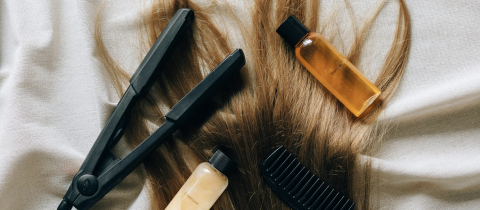In “Brazilian straightening” a protein known as keratin is mixed with formaldehyde and is applied to hair followed by heat treatment. Results can be surprisingly good with the straightening effect lasting for weeks. The problem is that the key substance in the treatment is formaldehyde, a compound with a cloud hanging over its head. Formaldehyde can not only cause allergic reactions, it is a possible carcinogen, especially when inhaled. The heat treatment volatilizes formaldehyde so inhalation is indeed possible. At concentrations above 0.1 ppm in the air formaldehyde can cause irritation of the eyes and throat and can trigger asthma in susceptible people. Such levels may be reached during a keratin treatment which is why hair dressers have taken to wearing masks when applying formaldehyde. Of course, the extent of exposure is critical and having such a treatment once in a while is not likely to be harmful, but working constantly with formaldehyde may present a risk. Supposedly these hair treatments contain only 0.2% formaldehyde, which is deemed to be safe, but the content of these products is not regulated in any way. Many are likely to contain far more formaldehyde given that 0.2% is not likely to deliver satisfactory hair straightening results.
Straightening hair involves some interesting chemistry. It all has to do with manipulating keratin, the protein that is the basic component of hair. Keratin can be thought of as long strings of amino acids with adjacent strings linked to each other through shorter bridges. A ladder, with the rungs representing these shorter bridges is an appropriate analogy. Chemically speaking, the rungs are actually two sulphur atoms that are joined to each other as well as to the long strands of amino acids. Hair straightening involves the breaking of these sulphur-sulphur bonds, combing the hair until it is straight, and then using some technique to form new links between the chains, holding them in their novel configuration. In the “keratin hair treatment,” the sulphur-sulphur bonds are broken by heat, and it is the formaldehyde that then forms the new rungs between the keratin chains. But it is not only formaldehyde that is added, keratin extracted from sheep’s wool is also part of the mix. The idea is that this keratin binds to the hair’s natural keratin, helping to hold the new shape. The importance of this added keratin isn’t clear; the major straightening effect is undoubtedly due to the treatment with formaldehyde and heat.
Because of the concern over formaldehyde, some “Brazilian” products advertise that they are formaldehyde-free. That may be so, but then they are likely to contain either glutaraldehyde or glyoxal, both of which, like formaldehyde, belong to the family of compounds known aldehydes. Glutaraldehyde and glyoxal are similar to formaldehyde in function and safety profile, so “formaldehyde-free” does not necessarily mean that adverse reactions are less likely. There’s no great risk in giving a straightening treatment a try, but what’s wrong with curly hair?







